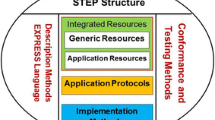Abstract
For the machining parts, the protrusion feature on the slanting face (PF-SF) is the most common machining feature. However, the machining information of the PF-SF cannot be easily obtained so that it reduces the efficiency of the process planning. Therefore, this paper proposes an algorithm to map the PF-SF to its manufacturing feature volume (MFV) based on the geometric reasoning method and the backward growing method. Based on PF-SF’s forming process and its typology relations, the PF-SF is divided into two types: single-volume protrusion feature and multiple volumes protrusion feature. Then, the PF-SF’s faces are recognized based on the developed geometric reasoning method. In order to obtain the MFV better, the PF-SF is divided into two sub-types based on its neighboring faces’ topological relation: the closed neighboring face set and the open neighboring face set. At last, the MFVs are formed by combining the recognized PF-SF faces with its extension neighboring faces or the created virtual plane. Two machined parts with the PF-SF are chosen as the case study to demonstrate the effectiveness of the developed approach.
Similar content being viewed by others
References
Chamberlain MA, Joneja A, Chang T-C (1993) Protrusion-features handling in design and manufacturing planning. Comput Aided Des 25(1):19–28
Yeol Lee J, Kim K (1998) A feature-based approach to extracting machining features. Comput Aided Des 30(13):1019–1035
Wang M-T, Chamberlain MA, Joneja A, Chang T-C (1993) Manufacturing feature extraction and machined volume decomposition in a computer-integrated feature-based design and manufacturing planning environment. Comput Ind 23(1):75–86
Deja M, Siemiatkowski MS (2013) Feature-based generation of machining process plans for optimised parts manufacture. J Intell Manuf 24(4):831–846
Han J, Pratt M, Regli WC (2000) Manufacturing feature recognition from solid models: a status report. Robot Autom IEEE Trans 16(6):782–796
Lin AC, Lin S-Y (1998) A volume decomposition approach to process planning for prismatic parts with depression and protrusion design features. Int J Comput Integr Manuf 11(6):548–563
Houshmand M, Imani DM, Niaki STA (2009) Using flower pollinating with artificial bees (FPAB) technique to determine machinable volumes in process planning for prismatic parts. Int J Adv Manuf Technol 45(9–10):944–957
Zheng Y, Taib JM, Tap MM (2012) Decomposition of interacting machining features based on the reasoning on the design features. Int J Adv Manuf Technol 58(1–4):359–377
Sakurai H, Dave P (1996) Volume decomposition and feature recognition, part II: curved objects. Comput Aided Des 28(6):519–537
Shah J, Shen Y, Shirur A (1994) Determination of machining volumes from extensible sets of design features. Manufact Res Technol 20:129–157
Waco D L, Kim Y S (1993) Considerations in positive to negative conversion for machining features using convex decomposition. Comput Eng 35–45
Sunil V, Agarwal R, Pande S (2010) An approach to recognize interacting features from B-Rep CAD models of prismatic machined parts using a hybrid (graph and rule based) technique. Comput Ind 61(7):686–701
Kim BC, Mun D (2014) Feature-based simplification of boundary representation models using sequential iterative volume decomposition. Comput Graph 38:97–107
Wong T, Lam S (2000) Automatic recognition of machining features from computer aided design part models. Proc Inst Mech Eng B J Eng Manuf 214(6):515–520
Chang M, Park SC (2008) An algorithm to extract machining volumes. Int J Adv Manuf Technol 36(9–10):942–949
Nonaka Y, Erdős G, Kis T, Kovács A, Monostori L, Nakano T, Váncza J (2013) Generating alternative process plans for complex parts. CIRP Ann-Manufact Technol 62(1):453–458
Vandenbrande JH, Requicha AA (1993) Spatial reasoning for the automatic recognition of machinable features in solid models. Pattern Anal Mach Intell IEEE Trans 15(12):1269–1285
McMahon C, Cox D, Williams JS, Scott J (1997) Representation and reasoning in computer aided process planning. Proc Inst Mech Eng B J Eng Manuf 211(6):473–485
Rahmani K, Arezoo B (2006) Boundary analysis and geometric completion for recognition of interacting machining features. Comput Aided Des 38(8):845–856
Liu Z, Wang L (2007) Sequencing of interacting prismatic machining features for process planning. Comput Ind 58(4):295–303
Hayasi MT, Asiabanpour B (2009) Extraction of manufacturing information from design-by-feature solid model through feature recognition. Int J Adv Manuf Technol 44(11–12):1191–1203
Yang J, Abdel-Malek K (2006) Verification of NC machining processes using swept volumes. Int J Adv Manuf Technol 28(1–2):82–91
Sae-Tang A, Arai E, Igoshi M (1996) Machined feature recognition based on feature loop and convex polyhedron. JSME Int J Ser C Dynam Control Robot Des Manufact 39(3):652–659
Zhang S, Shi Y, Fan H, Huang R, Cao J (2010) Serial 3D model reconstruction for machining evolution of rotational parts by merging semantic and graphic process planning information. Comput Aided Des 42(9):781–794
Sormaz DN, Khoshnevis B (2000) Modeling of manufacturing feature interactions for automated process planning. J Manuf Syst 19(1):28–45
Chen Z, Gao S, Li W (2007) An approach to incremental feature model conversion. Int J Adv Manuf Technol 32(1–2):99–108
Chu X, Tang C, Xue D, Su Y, Sun X (2012) Identification of machining features based on available resources of cutting tools. Int J Prod Res 50(15):4141–4157
Author information
Authors and Affiliations
Corresponding author
Rights and permissions
About this article
Cite this article
Liu, J., Liu, X., Cheng, Y. et al. An algorithm of mapping the protrusion feature on the slanting face to its manufacturing feature volume in the process planning. Int J Adv Manuf Technol 79, 361–376 (2015). https://doi.org/10.1007/s00170-015-6810-2
Received:
Accepted:
Published:
Issue Date:
DOI: https://doi.org/10.1007/s00170-015-6810-2



